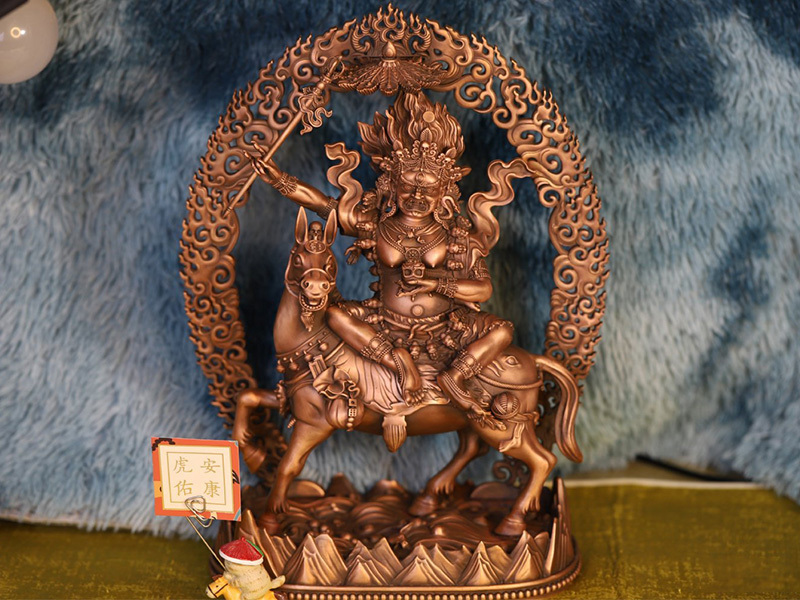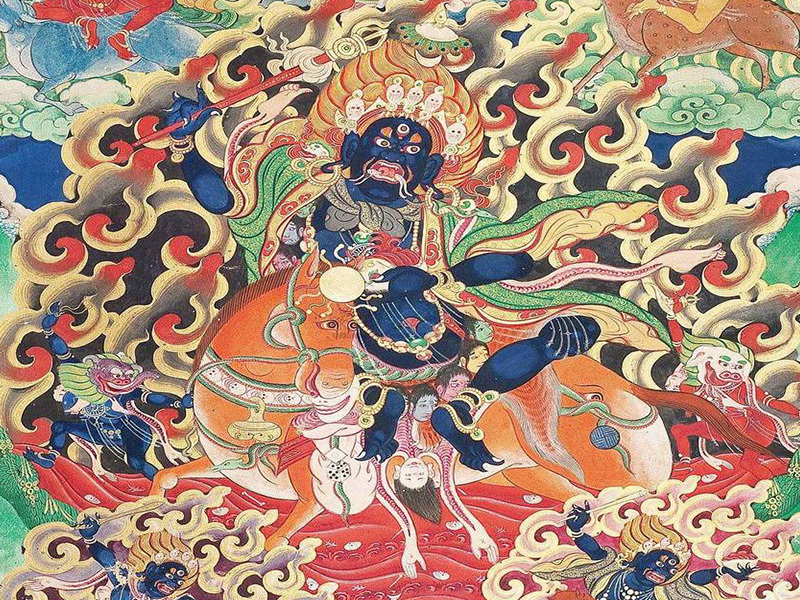Palden Lhamo
- by Catherine
- Last Updated: 2023-03-25
Palden Lhamo is the tutelary deity of Tibet and the chief Dharma Protector. Palden Lhamo means "Glorious Goddess" in Tibetan. She is the goddess of happiness and wealth. Being the protector of Lhasa, Lhasa is the richest city in Tibet. During Langdama's anti-Buddha campaign, Palden Lhamo protected Tibetan Buddhism. Therefore, Palden Lhamo is regarded as the most auspicious guardian deity in Tibet and the protector of green Tara. No matter the large or small monasteries, as well as Potala Palace, there all enshrine her statues, thangkas and murals. In the Gelug sect of Tibetan Buddhism, she is also the principal protectress.
How to Tell?

Feature
A three-eyed mule mount
A green snake bridle
A human-skin saddle blanket and the dice with bridle
Posture and Holding Stuff
She is usually depicted sitting sideways on a yellow mule and biting the corpse. Her upper body is naked, with sagging breasts. Her right hand holds up a vajry pestle or long weapons such as scepters or swords. And her left hand holds a skull cup full of demon blood. She wears a lower garment of tiger skin and belts and bracelets of poisonous snakes. When she appears in the four-armed form, the extra two arms hold a trident and a Puba pestle.
Special Clothing
Like other Dharma protectors, Palden Lhamo wears the five-skull crown, as well as a necklace and earrings of human heads. Yet she has many very special features, such as the peacock feather and crescent moon ornaments on her red hair. The sun-shaped pattern on the navel is said to be a gift from vish-nu, one of the three main gods of India.
Mount
Her mount is a yellow mule. This yellow mule has a red tongue and wears a skull necklace, dressed in an imposing manner. The most eye-catching thing is the riding equipment on the mule including a human skin saddle with a dangling head. The corpse is said to be the demonic son of Palden Lhamo. There are two dice tied to the saddle, which are the main utensil used in Tibetan divination. In addition, the green long snake bridle, that is, the rein placed on the mule's strength is also one of its distinguishing features.
Legend
According to legend, Palden Lhamo is a goddess with distinct love and hate. When she decided to leave her husband, the devil king of Lanka, she rode her beloved yellow mule across the oceans and across the mountains to Tibet.
On her way to escape, her husband chased after the mule desperately, shooting a poisoned arrow that hit the mule in the rump. Palden Lhamo used her magical power to immediately heal the wound and transformed it into an eye, so as to monitor the pursuers behind.

There is more than one such story, and Palden Lhamo in these stories can always turn bad luck into good fortune and survived. After leaving the devil king of Lanka, she is said to be the consort of Mahakala. Another saying is that she was the consort of Shiva, the main god of Hinduism and later consorted with Vaisravana.
Blessing Power
Normally a prayer to Palden Lhamo is always answered. No matter what difficulties you encounter, pray sincerely in front of the Buddhist hall and recite the mantra, then, Palden Lhamo will ride into your heart as fast as lightning, and all your good wishes will be achieved. Therefore, many believers will recite the prayers of Palden Lhamo, and enshrine tea and wine, as well as other offerings to pray. In Tibet, almost all temples enshrine and practice Palden Lhamo dharma. Different traditions have different prayers.
Lake Lhamo La-tso
In Tibet, this goddess was associated with the identifications of living Buddhas.
Located in Gyaca County, Shannan Prefecture, more than 300 kilometers away from Lhasa, Lhamo La-tso Lake is the famous lake of Palden Lhamo. Lhamo La-tso means holy goddess lake hanging in the sky.
It is said that one can see one's previous, present, and later life from the image appearing in the lake. Every Dalai lama has to worship this lake once in their life and talks to Palden Lhamo, to know his life and the scene of his death. Because the vision is terrible, you have to turn your head first.

Jokhang Temple
Palden Lhamo is the principal guardian of the Jokhang Temple in Lhasa, as well as the protectress of wealth.
When the Tibetan king Songtsen Gampo built the Jokhang Temple, he asked her to be the guardian of the Jokhang Temple. Since then, Jokhang Temple has become the richest monastery in Tibet.
Every year on October 15th of the Tibetan calendar, it is the "Palden Lhamo Festival". All temples will hold a grand offering ritual to the Dharma Protectress Palden Lhamo of the Jokhang Temple in Lhasa. On the night before, the monks will worship her statue in the Buddha Shakyamuni hall, making it sit opposite Shakyamuni Buddha. In the early morning of the 15th, the monks will carry her statue to Jokhang Temple square for the blessing of all beings. On this day, all Tibetan women will dress up and pray for happiness and wealth from Palden Lhamo.
Symbolism of Palden Lhamo
Different from the gentle female image in people's minds, Palden Lhamo appears extremely wrathful and mighty.
Her body is deep blue, with one head, two arms, and three eyes. She rides side-saddle on a yellow mule (four eyes), and she wears a tiger-skin lower garment, crossing a sea of blood. She has a poison snake as an earring on her left ear, indicating listening to Dharma. And she has a lion as an earring on the right, indicating killing demons.
Dharmapalas are the wrathful forms of enlightened Buddhas. They shoulder the responsibility of protecting Triratna as well as protecting practitioners. They give the practitioners favorable conditions for practice and remove the obstacles on the way to practice. Mahakala and Palden Lhamo are both Dharmapalas of lokuttara. For different incarnations, it means different natures. The wrathful deity usually appears in fierce form, which indicates to subduing troubles and obstacles but not show wrath all living beings. Their outward appearance is fearsome, but their inner nature is full of Buddhas'compassion, not hatred. Palden Lhamo is not only the protector of the teachings of Sakyamuni but also the protector of the teachings of the Buddha as far back as the time of Kassapa Buddha.
Related Articles
-
Tibetan Calendar
Tibetan Calendar is widely used in Tibet as the crystallization of Tibetan wisdom and experience. It is calculated by astrologers from Mentse Khang every year. -
Prayer Wheel - Every Turn is Equivalent to Chanting Once
Prayer Wheel is a Tibetan Buddhist ritual item with scriptures or mantras installed inside. Every turn is equivalent to chanting the sutra once. -
Tibetan Cham Dance
Cham is a religious dance associated with Tibetan Buddhism. It provides compassionate guidance and bestows merit upon devotees. -
Tibetan Sky Burial Custom
Tibetan Sky Burial is a traditional funeral ritual for Tibetan Buddhists, in which the dead body is consecrated to the vultures, to get into reincarnation ... -
Tibetan Handicrafts
Handmade art has been an indispensable part of people's lives such as Thangka, Tibetan incense, Tibetan medicine, Tibetan ornaments, etc. -
Tibet Religion
Tibet religion starts from Yungdrung Bon, the indigenous region of the Tibetan Plateau. After Buddhism spread to Tibet, Bon religion also greatly influenced it. -
Tibetan Thangka Painting
Tibetan thangka is a scroll painting used for worship in Tibetan Buddhism with distinct national characteristics, religious color and unique style. -
Tibetan Knife
Tibetan knives here are the most commonly used in hunting, and they are a sharp weapon for breaking through brambles and thorns. -
Tibetan Buddhism
Tibetan Buddhism is the branch of Buddhism introduced into Tibet. It is divided into five major sects: Kadampa, Nyingmapa, Kagyupa, Sakyapa and Gelugpa. -
Unveiling the Mystery of Longda
Many people scatter scraps of paper into the sky for the purpose of seeking blessing from God. Those scraps of paper are called Longda. -
Tibetan Nomads
Tibetan Nomads are one of the ethnicities who prefer the nomadic lifestyle. They have no fixed residence for long and choose places with grass and water.
Email response within 0.5~24 hours.


